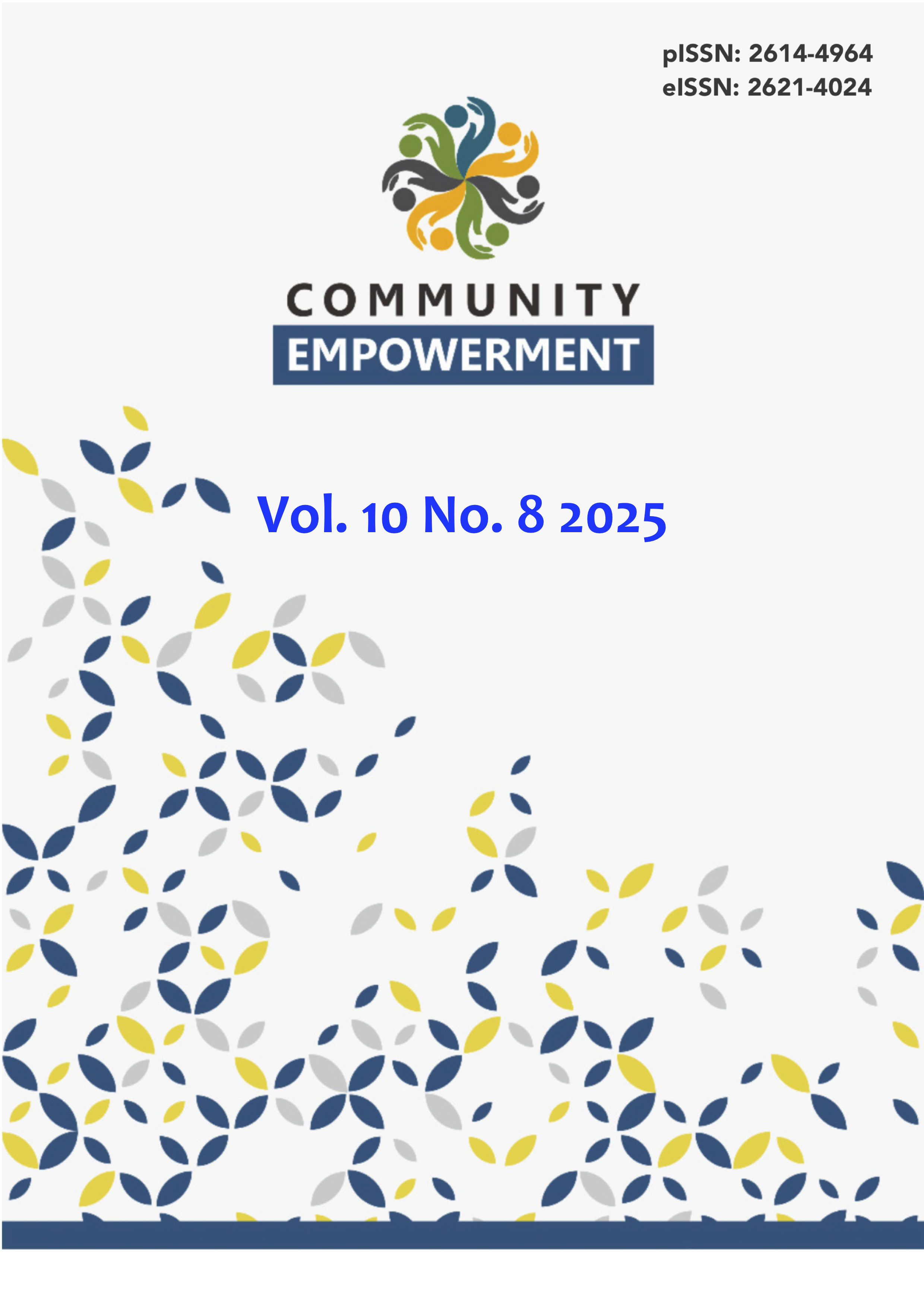Main Article Content
Abstract
Rice husk waste is an abundant agricultural byproduct in Karang Langit Village, Lamongan, but its utilization is still limited, posing a potential environmental problem. This community service program aims to modernize agricultural practices by utilizing rice husk as a hydroponic growing medium to support food security and promote a circular economy. The methods applied include community coordination, carbonization of rice husks, preparation of the hydroponic system, and both theoretical and practical hands-on training. Evaluation results show a significant increase in participants’ knowledge by 32%. A total of 85% of participants successfully prepared a viable rice-husk-based growing medium, and 75% were able to cultivate and harvest leafy vegetables in the trial phase. Additionally, a farmer group was formed and is committed to independently continuing hydroponic practices after the program’s conclusion. These results confirm that utilizing rice husk as a hydroponic medium not only enhances community skills and self-sufficiency but also opens new economic opportunities. This model is recommended for replication in other agricultural areas to support local food security and environmental sustainability.
Keywords
Article Details

This work is licensed under a Creative Commons Attribution-NonCommercial 4.0 International License.
References
- Adekiya, A. O., Adebiyi, O. V., Ibaba, A. L., Aremu, C., & Ajibade, R. O. (2022). Effects of wood biochar and potassium fertilizer on soil properties, growth and yield of sweet potato (Ipomea batata). Heliyon, 8(11), e11728. https://doi.org/10.1016/j.heliyon.2022.e11728
- Alam, M. N. H. Z. A., Othman, N. S. I. A., Samsudin, S. A., Johari, A., Hassim, M. H., & Kamaruddin, M. J. (2020). Carbonized rice husk and cocopeat as alternative media bed for aquaponic system. Sains Malaysiana, 49(3), 483–492. https://doi.org/10.17576/jsm-2020-4903-03
- Carnevali, N. H. de S., Ramos, D. D., & Scalon, S. de P. Q. (2010). Sweet basil (Ocimum basilicum L.) seedling production in different substrates and luminosities. Revista Brasileira de Plantas Medicinais, 13(3), 276–281. https://doi.org/10.1590/S1516-05722011000300005
- Castoldi, G., Freiberger, M. B., Pivetta, L. A., Pivetta, L. G., & Echer, M. de M. (2014). Alternative substrates in lettuce seedling production. Revista Ciência Agronômica, 45(2), 299–304. https://doi.org/10.1590/S1806-66902014000200010
- Chatterjee, A., Ghosh, P., Winkler, B., V, V., Debnath, S., Cichocki, J., Trenkner, M., Vanicela, B., Riethmueller, C., Walz, M., Chandra, S., & Pal, H. (2025). Demystifying the integration of hydroponics cultivation system reinforcing bioeconomy and sustainable agricultural growth. Scientia Horticulturae, 341, 113973. https://doi.org/10.1016/j.scienta.2025.113973113456
- Huang, L., Niu, G., Feagley, S. E., & Gu, M. (2019). Hardwood biochar as peat replacement. Industrial Crops and Products, 129, 549–560. https://doi.org/10.1016/j.indcrop.2018.12.044
- Júnior, L. A. Z., Andrade, E. A., Pereira, N., Tokura, L. K., Secco, D., & Carvalho-Zanão, M. P. (2022). Contribution of the carbonized rice husk added to the substrate in the production of vegetable seedlings. Bioscience Journal, 38, e38029. https://doi.org/10.14393/BJ-v38n0a2022-54050
- Morano, G., Amalfitano, C., Sellitto, M., Cucinello, A., Maiello, R., & Caruso, G. (2017). Effects of nutritive solution electrical conductivity and plant density on growth, yield and quality of sweet basil grown in gullies by subirrigation. Advances in Horticultural Science, 31(1), 25–30. https://doi.org/10.13128/ahs-20722
- Nafiah, O. Z., Pangesti, N., & Makhziah. (2023). The effect of hydroponic nutrient sources and planting media types on the growth and production of Chinese kale (Brassica oleracea L.). Jurnal Teknik Pertanian Lampung, 12(2), 443–457. https://doi.org/10.23960/jtep-l.v12i2.443-457
- Pinheiro, M. V. M., Holz, E., Webler, A. R., Masarro-Araujo, G., Thiesen, L. A., Knapp, F. M., Diel, M. I., & Schmidt, D. (2022). Substrates based on carbonized rice husk alter strawberry productivity in a semi-hydroponic system. Research, Society and Development, 11(14), e3634714305. https://doi.org/10.33448/rsd-v11i14.36347
- Rosli, N. S. M., Abdullah, R., Yaacob, J. S., & Razali, R. B. R. (2023). Effect of biochar as a hydroponic substrate on growth, colour and nutritional content of red lettuce (Lactuca sativa L.). Bragantia, 82(14), e20220177. https://doi.org/10.1590/1678-4499.20220177
- Salé, M. M., Pereira, A. S., Junior, H. L., Neutzling, C., Santos, P. M. Dos, Schiedeck, G., & Dorneles, A. O. S. (2021). Carbonized rice husk as an alternative substrate for Ocimum basilicum L. seedling production. Acta Agronómica, 70(1), 93–100. https://doi.org/10.15446/acag.v70n1.87771
- Sufi, W., Rachman, F., & Nasution, A. (2022). Assistance in the climate village program in increasing food security in Tobek Godang Village. Community Empowerment, 7(4), 1120–1128. https://doi.org/10.31603/ce.5784
- Thapa, U., Hansda, N. N., Kundu, S., Giri, A., Tamang, D., & Rahaman, A. O. (2024). Advancements in hydroponic systems: A comprehensive review. Archives of Current Research International, 24(11), 317–328. https://doi.org/10.9734/acri/2024/v24i11973
- Wahab, A., Ramadhani, F., & Noor, H. (2025). Empowering local MSMEs through digital sharia to foster the halal industry in South Kalimantan. Community Empowerment, 10(7), 3122–3130. https://doi.org/10.31603/ce.12306
- Wulandari, R., Buddhisatyarini, T., & Fifintari, F. R. (2022). Empowerment of urban communities in utilizing small courtyards with hydroponic technology. Community Empowerment, 7(8). https://doi.org/10.31603/ce.6243

